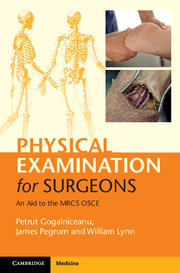Book contents
- Frontmatter
- Dedication
- Contents
- List of contributors
- Introduction
- Acknowledgments
- List of abbreviations
- Section 1 Principles of surgery
- Section 2 General surgery
- Section 3 Breast surgery
- Section 4 Pelvis and perineum
- Section 5 Orthopaedic surgery
- Section 6 Vascular surgery
- Section 7 Heart and thorax
- Section 8 Head and neck surgery
- 32 Examination of the ear
- 33 Examination of the nose
- 34 Examination of the throat
- 35 Oral and maxillofacial examination
- 36 Examination of the neck and thyroid
- Section 9 Neurosurgery
- Section 10 Plastic surgery
- Section 11 Surgical radiology
- Section 12 Airway, trauma and critical care
- Index
34 - Examination of the throat
from Section 8 - Head and neck surgery
Published online by Cambridge University Press: 05 July 2015
- Frontmatter
- Dedication
- Contents
- List of contributors
- Introduction
- Acknowledgments
- List of abbreviations
- Section 1 Principles of surgery
- Section 2 General surgery
- Section 3 Breast surgery
- Section 4 Pelvis and perineum
- Section 5 Orthopaedic surgery
- Section 6 Vascular surgery
- Section 7 Heart and thorax
- Section 8 Head and neck surgery
- 32 Examination of the ear
- 33 Examination of the nose
- 34 Examination of the throat
- 35 Oral and maxillofacial examination
- 36 Examination of the neck and thyroid
- Section 9 Neurosurgery
- Section 10 Plastic surgery
- Section 11 Surgical radiology
- Section 12 Airway, trauma and critical care
- Index
Summary
Checklist
WIPER
• Position and expose as for ear examination. Ensure dentures are removed. Inspect with a headlight.
Physiological parameters
Inspection
• Listen to the voice and breathing.
• Front and side: neck scars, stigmata of radiotherapy to the head and neck.
• Oral cavity/oropharyngeal inspection (see Chapter 35, Oral and maxillofacial examination):
• 2 tongue depressors: lips, tongue, teeth, gingiva, parotid duct opening, floor of mouth, submandibular duct
• 1 tongue depressor: hard palate, soft palate, tonsil, posterior pharyngeal wall, posterior tongue
Palpate
• Floor of mouth: submandibular salivary calculus, tumour
• Parotid duct: salivary calculus
• Tonsils and tongue for tumour
Laryngopharyngoscopy
• Flexible nasolaryngopharyngoscopy
To complete the examination…
• Examine the neck for regional lymphadenopathy (see Chapter 36, Examination of the neck and thyroid).
Examination notes
How do you perform flexible nasolaryngopharyngoscopy?
• Explain what you are going to do. In particular, warn that the eyes may water, that one may feel the need to sneeze and that the endoscope can cause discomfort.
• Spray co-phenylcaine into both nostrils and ideally allow it to work for 5–10 minutes.
• Warn the patient not to eat or drink for the next 30 minutes to avoid aspiration or burning the throat.
• Wear gloves and prepare the endoscope – connect the light source, if a sheath is available place it over the endoscope, lubricate the end with aqueous jelly and then either use anti-fog on the tip or warm the tip of the endoscope on the patient's tongue.
• The patient should be sitting with the head resting against a wall, so that the head cannot be drawn back.
• Pass the endoscope into the nasal vestibule on either side under direct vision. Once in the vestibule, if the examined side looks obviously narrowed then pass the endoscope through the contralateral side. In almost all patients the endoscope can be successfully passed between the middle and inferior turbinate.
- Type
- Chapter
- Information
- Physical Examination for SurgeonsAn Aid to the MRCS OSCE, pp. 288 - 291Publisher: Cambridge University PressPrint publication year: 2015



